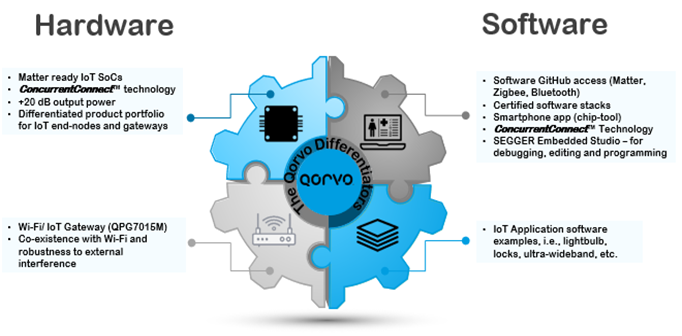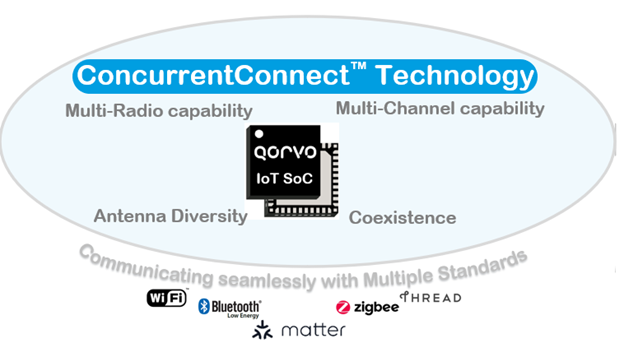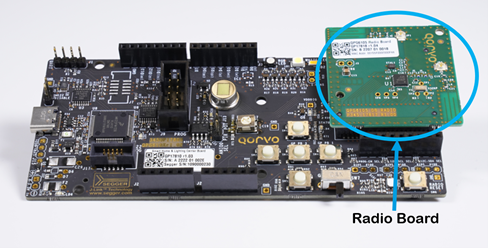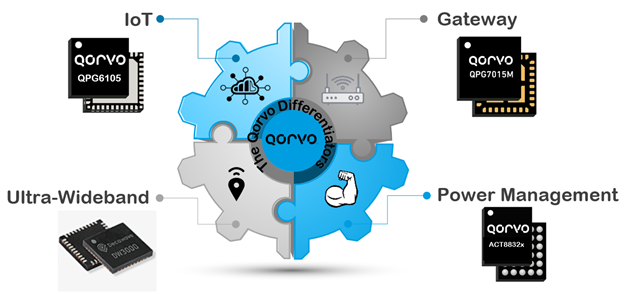Introduction
To ensure your Internet of Things (IoT) product is competitive or differentiated in the marketplace, you need to build it with components that offer unique features. Some component suppliers strive to provide these market unique features, while others do not. However, to stay ahead of the crowded marketplace of the IoT, standing out is key.
In this article we explore how Qorvo provides semiconductor system-on-chips (SoCs) that are differentiated to help you develop a unique next-generation IoT product. We also review some of the key hardware and software features we offer that our competitors may not.
Designing with Unique Software and Hardware
Before jumping into any IoT product design, let's review some of the top-two development topics that can help separate your product from others in the marketplace – Hardware and Software. Choosing attributes within these two areas can help make your design process easier and distinguish your product among the competition.

Figure 1: Qorvo hardware and software differentiators
Component manufacturers typically work to provide some form of differentiation between competitor products within these two groups. Qorvo system designers have worked diligently to provide diversity between the competitive IoT marketplace. We will dig into this in more detail below.
The Hardware Differentiators
Let's begin by looking at the IoT component hardware pillar. To stay current and above the competition component manufacturers must design with Matter ready SoCs. The Matter standard will help make the difference between interoperability, ease of use and reliable communications in the IoT network. Therefore, those component manufacturers overlooking this new Matter standard in their product will ultimately make things harder for product designers and consumers.
In addition to making the IoT component using the Matter standard, new unique hardware differentiators can further accelerate your design process, provide customer ease-of-use and distinguish the product from the IoT competition. Qorvo provides this technology differentiator by adding its ConcurrentConnect™ technology.
ConcurrentConnect technology is a unique SoC advancement that provides several key aspects to ensure robust communication between the gateway, border router and end-nodes.

Figure 2: ConcurrentConnect Technology
ConcurrentConnect technology provides:
- Multi-Radio capability
- Unrestricted concurrent Thread/Matter + Zigbee + Bluetooth Low Energy communications with a single radio
- Combines any Bluetooth Low Energy role concurrently with any Zigbee or Thread/Matter role
- Multi-Channel capability
- Operates 2 or more 802.15.4 networking technologies like Zigbee & Matter or multiple Matter networks on different channels with a single chip
- Antenna Diversity
- Delivers RF range and capacity in all applications
- Coexistence
- On-chip coexistence between Matter, Bluetooth, Zigbee and Thread
- Off-chip Wi-Fi transmitter coexistence including unique early preamble detect and MAC filtering – minimizing latency and packet errors for IoT and Wi-Fi networks
ConcurrentConnect Multi-Radio enables running multiple IoT protocols like Zigbee, Bluetooth Low Energy or Matter concurrently using a single radio. This lowers the components on the bill-of-material, PC board size and design time. Competing silicon implements time-multiplexing (referred to as Dynamic Multi-protocol) to combine multiple radio technologies, which inevitably reduces the possible use cases that can be built using a single-chip solution.
Qorvo's ConcurrentConnect Multi-Radio Technology takes Dynamic Multi-protocol a step further to achieve multi-standard seamless communications. It is the only technology capable of combining all modes and use cases of Matter, Zigbee and Bluetooth Low Energy concurrently with a single chipset. The concurrency is completely dealt with in the SoC without any added complexity in the application software to time slice or multiplex the radio. With ConcurrentConnect Multi-Radio technology the SoC is continuously scanning for incoming data packets across multiple radio standards to ensure no dropped communications occur.
Along with ConcurrentConnect and Matter enablement, Qorvo makes certain your IoT device can maximize its RF range and minimize amount of data retransmissions. By providing a SoC with up to +20 dB of output power, we can enable your IoT product for all transmission situations. Additionally, we offer on-chip antenna diversity for maximum reliability, even in indoor environments with many interferences from other devices. Qorvo's development kits have antenna diversity enabled on the radio board to ensure the IoT end-node and gateway provide the most optimal RF range and communication performance. With these two differentiators (antenna diversity and +20 dB power output) you can be assured your IoT device will work without issue in all environments and all standards.

Figure 3: Development kit radio board with antenna diversity functionality.
At Qorvo we understand that a gateway product has different needs compared to an end node product. Our gateway, the QPG7015M, provides software and RF design engineers with the required tools to develop and analyze IoT applications. Along with having our unique ConcurrentConnect technology, the QPG7015M applications are built on top of a Linux Operating System (OS), the typical OS used in smart home gateways. Using the QPG7015M, software designers can work in the development environment they are familiar with and leverage the powerful Linux API to build their desired application. Moreover, the development kit comes with a Raspberry Pi, which runs the user application software mimicking the architecture of typical gateway products.
Additionally, the QPG7015M provides Wi-Fi/IoT coexistence tooling for configuring and verifying the three-wire coexistence protocols between the different radios. Therefore, using the QPG7015M, IoT coexistence becomes easy--the developer only needs to configure coexistence with Wi-Fi. Qorvo's gateway solutions not only can be used to develop unique and differentiating gateway products, but they also assist you in creating and testing an end-to-end IoT solution.
From a hardware perspective our SoCs remove the limitations and challenges seen in many of today's IoT network environments. Qorvo goes a step further by offering hardware capabilities beyond the traditional IoT end-node. The development board has plug-in areas to allow you to create fully functional Ultra-Wideband (UWB) designs by using our UWB SoC products. Also, we can provide power management SoCs to help you create the most power efficient design possible. (See Figure 4) This provides developers with all the needed products and guarantees they will coexist and cohesively work together to provide you an easy pathway to your desired IoT system.

Figure 4: Technology offerings of Qorvo for IoT product solutions.
The Software Differentiators
In today's IoT marketplace, software is just as important as the hardware. Software is the engine that drives the hardware and ensures the system is optimally tuned. Qorvo provides a great out-of-the-box experience and well-supported documentation at each phase of your IoT development. Our software tools are easy to use, accessible and work effectively with the hardware.
Our IoT software is free-to-use with the Qorvo SoC's and publicly available on our GitHub webpage. Our IoT software tools are not only Zigbee and Bluetooth capable but are also Matter capable. Additionally, we offer free software development tools to assist you during product design all the way to mass production.
Our Qorvo development kits contain all the needed certified software, split into core building blocks such as hardware drivers for IC functionality, communication stacks (i.e., Bluetooth LE, Zigbee, Matter, and Thread) operating system and applications. Our turnkey applications combine software building blocks in a typical use case, like lightbulb, switch or lock, and can be used by customers to shorten design time. We also provide the ability to customize the software and design to deploy new products.
Financing an expensive IoT development is challenging and sometimes risky. Especially when you are working with new software protocols and technologies. Qorvo offers free licensing for SEGGER Embedded Studio, which allows customers to access a user-friendly development software environment for editing, programming and debugging your application.
Staying ahead of the competition in any business is a challenge. To do so you need to stand out from the crowd by using differentiated components and developing a distinguished product. This has become challenging for developers as they sometimes must weigh attributes between hardware and software. Qorvo, removes that challenge by offering complete fully certified products, applications and software. We also can provide additional differentiated technology and tools like, ConcurrentConnect technology, integration of Ultra-Wideband (UWB) and Power Management, fully developed gateways and technologies, and more. With a complete bundle of hardware and software IoT and network solutions, the developers' design process is easier and differentiated to help drive sales.
